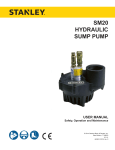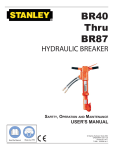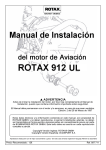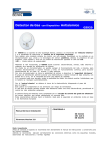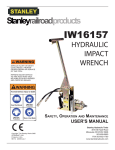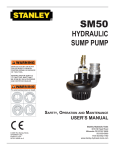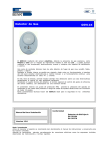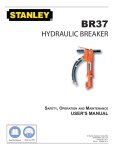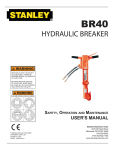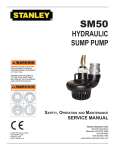Download SM20 User Manual 1-2010.indb
Transcript
SM20 HYDRAULIC SUMP PUMP SAFETY, OPERATION AND MAINTENANCE USER’S MANUAL Read the Manual Wear your PPE © 2005 The Stanley Works USER/MAINT USA Printed in U.S.A. 66393 1/2010 ver 3 TABLE OF CONTENTS CERTIFICATE OF CONFORMITY................................................................................................................................................... 4 SAFETY SYMBOLS......................................................................................................................................................................... 5 SAFETY PRECAUTIONS ................................................................................................................................................................ 6 TOOL STICKERS & TAGS .............................................................................................................................................................. 8 HYDRAULIC HOSE REQUIREMENTS ........................................................................................................................................... 9 HTMA REQUIREMENTS ............................................................................................................................................................... 10 OPERATION .................................................................................................................................................................................. 11 PREOPERATION PROCEDURES............................................................................................................................................. 11 CHECK POWER SOURCE ........................................................................................................................................................ 11 CONNECT HOSES .................................................................................................................................................................... 11 PUMP OPERATION ................................................................................................................................................................... 11 WHEN PUMPING WATER MIXED WITH SOLIDS .................................................................................................................... 11 COLD WEATHER OPERATION .................................................................................................................................................... 12 MAINTENANCE ............................................................................................................................................................................. 12 CLEANING THE PUMPING CHAMBER........................................................................................................................................ 12 EQUIPMENT PROTECTION & CARE........................................................................................................................................... 13 TROUBLESHOOTING ................................................................................................................................................................... 14 SPECIFICATIONS ......................................................................................................................................................................... 15 ACCESSORIES ............................................................................................................................................................................. 15 SM20 PARTS ILLUSTRATION ...................................................................................................................................................... 16 SM20 PARTS LIST ........................................................................................................................................................................ 17 WARRANTY................................................................................................................................................................................... 18 SERVICING THE STANLEY HYDRAULIC Sump Pump. This manual contains safety, operation, and routine maintenance instructions. Stanley Hydraulic Tools recommends that servicing of hydraulic tools, other than routine maintenance, be performed by an authorized and certified dealer. Please read the following warning. SERIOUS INJURY OR DEATH COULD RESULT FROM THE IMPROPER REPAIR OR SERVICE OF THIS TOOL. REPAIRS AND / OR SERVICE TO THIS TOOL MUST ONLY BE DONE BY AN AUTHORIZED AND CERTIFIED DEALER. For the nearest authorized and certified dealer, call Stanley Hydraulic Tools at the number listed on the back of this manual and ask for a Customer Service Representative. 3 CERTIFICATE OF CONFORMITY CERTIFICATE OF CONFORMITY ÜBEREINSTIMMUNGS-ZERTIFIKAT CERTIFICAT DE CONFORMITE CEE CERTIFICADO DE CONFORMIDAD CERTIFICATO DI CONFORMITA I, the undersigned: Ich, der Unterzeichnende: Je soussigné: El abajo firmante: lo sottoscritto: Hydraulic Tools Piert, Charlie Surname and First names/Familiennname und Vornamen/Nom et prénom/Nombre y apellido/Cognome e nome hereby certify that the construction plant or equipment specified hereunder: bestätige hiermit, daß das im folgenden genannten Werk oder Gerät: certifies par ceci que l’ usine ou l’ équipement de construction indiqué cidessous: por el presente certifico que la fabrica o el equipo especificado a continuacion: certifico che l’impianto o l’attrezzatura sotto specificata: 1. Category: Kategorie: Catégorie: Categoria: Categoria: Submersible Pump, Hydraulic 2. Make/Ausführung/Marque/Marca/Marca 3. Type/Typ/Type/Tipo/Tipo: 4. Serial number of equipment: Seriennummer des Geräts: Numéro de série de l’équipement: Numero de serie del equipo: Matricola dell´attrezzatura: Stanley SM2043101, SM2043107, SM2052101, SM2053101 All 5. Year of manufacture/Baujahr/année de fabrication/Año de fabricacion/Anno di fabbricazione Has been manufactured in conformity with - EEC Type examination as shown. Wurde hergestellt in Übereinstimmung mit - EEC Typ-Prüfung nach. Est fabriqué conformément - au(x) type(s) examiné(s) comme indiqué dans le tableau ci-après. Ha sido fabricado de acuerdo con - tipo examen EEC como dice. E’ stata costruita in conformitá con - le norme CEE come illustrato. Beginning 2002 Examen CEE de type Directive Richtlinie Directives particulières Directriz Direttiva No. Nr Numéro No n. Date Datum Date Fecha Data Approved body Prüfung durch Organisme agréé Aprobado Collaudato Date of expiry Ablaufdatum Date d´expiration Fecha de caducidad Data di scadenza EN Machinery directive 809 98/37/EC 1995 1998 Self Self NA NA 6. Special Provisions: None Spezielle Bestimmungen: Dispositions particulières: Provisiones especiales: Disposizioni speciali: 7. Representative in the Union: Stanley Dubuis 17-19, rue Jules Berthonneau-BP 3406 41034 Blois Cedex, France. Done at/Ort/Fait à/Dado en/Fatto a Stanley Hydraulic Tools, Milwaukie, Oregon USA Date/Datum/le/Fecha/Data 7/30/2002 Signature/Unterschrift/Signature/Firma/Firma__________________________________________________________________________ Position/Position/Fonction/Puesto/Posizione Quality Assurance Manager Ver-4 11/09 4 SAFETY SYMBOLS Safety symbols and signal words, as shown below, are used to emphasize all operator, maintenance and repair actions which, if not strictly followed, could result in a life-threatening situation, bodily injury or damage to equipment. This is the safety alert symbol. It is used to alert you to potential personal injury hazards. Obey all safety messages that follow this symbol to avoid possible injury or death. DANGER This safety alert and signal word indicate an imminently hazardous situation which, if not avoided, will result in death or serious injury. WARNING This safety alert and signal word indicate a potentially hazardous situation which, if not avoided, could result in death or serious injury. CAUTION This safety alert and signal word indicate a potentially hazardous situation which, if not avoided, may result in minor or moderate injury. This signal word indicates a potentially hazardous situation which, if not avoided, may result in property damage. NOTICE This signal word indicates a situation which, if not avoided, will result in damage to the equipment. IMPORTANT This signal word indicates a situation which, if not avoided, may result in damage to the equipment. Always observe safety symbols. They are included for your safety and for the protection of the tool. LOCAL SAFETY REGULATIONS Enter any local safety regulations here. Keep these instructions in an area accessible to the operator and maintenance personnel. 5 SAFETY PRECAUTIONS Tool operators and maintenance personnel must always comply with the safety precautions given in this manual and on the stickers and tags attached to the tool and hose. These safety precautions are given for your safety. Review them carefully before operating the tool and before performing general maintenance or repairs. Supervising personnel should develop additional precautions relating to the specific work area and local safety regulations. If so, place the added precautions in the space provided in this manual. The models SM20 Hydraulic Pump will provide safe and dependable service if operated in accordance with the instructions given in this manual. Read and understand this manual and any stickers and tags attached to the pump and hoses before operation. Failure to do so could result in personal injury or equipment damage. • Operator must start in a work area without bystanders. The operator must be familiar with all prohibited work areas such as excessive slopes and dangerous terrain conditions. • Establish a training program for all operators to ensure safe operations. • Do not operate the tool unless thoroughly trained or under the supervision of an instructor. • Always wear safety equipment such as goggles, head protection, and safety shoes at all times when operating the tool. • Do not inspect or clean the tool while the hydraulic power source is connected. Accidental engagement of the tool can cause serious injury. • Do not operate this tool without first reading the Operating Instructions. • Do not install or remove this tool while the hydraulic power source is connected. Accidental engagement of the tool can cause serious injury. • Never operate the tool near energized transmission lines. know the location of buried or covered services before starting work. • Do not wear loose fitting clothing when operating the tool. Loose fitting clothing can get entangled with the tool and cause serious injury. • Supply hoses must have a minimum working pressure rating of 2500 psi/175 bar. • Be sure all hose connections are tight. • The hydraulic circuit control valve must be in the “OFF” position when coupling or uncoupling the tool. Wipe all couplers clean before connecting. Failure to do so may result in damage to the quick couplers and cause overheating. Use only lint-free cloths. • Do not operate the tool at oil temperatures above 140° F/60° C. Operation at higher oil temperatures can cause operator discomfort and may cause damage to the tool. • Do not operate a damaged, improperly adjusted, or incompletely assembled tool. • Do not put hand under volute while the pump is running. • To avoid personal injury or equipment damage, all tool repair, maintenance and service must only be 6 SAFETY PRECAUTIONS performed by authorized and properly trained personnel. • Do not exceed the rated limits of the tool or use the tool for applications beyond its design capacity. • Always keep critical tool markings, such as labels and warning stickers legible. • Always replace parts with replacement parts recommended by Stanley Hydraulic Tools. • Check fastener tightness often and before each use daily. • Do not point water discharge at bystanders. 7 TOOL STICKERS & TAGS 28323 CE Decal (CE Only) 11207 Circuit Type C Decal (CE Only) 11206 Circuit Type D Decal (CE Only) (SM2052101 Only) 28788 fManual Decal 28785 Model Decal (SM2052101 Only) 28786 Coupler Decal D A N G E R D A N G E R 1. FAILURE TO USE HYDRAULIC HOSE LABELED AND CERTIFIED AS NON-CONDUCTIVE WHEN USING HYDRAULIC TOOLS ON OR NEAR ELECTRICAL LINES MAY RESULT IN DEATH OR SERIOUS INJURY. 28784 Model Decal BEFORE USING HOSE LABELED AND CERTIFIED AS NON-CONDUCTIVE ON OR NEAR ELECTRIC LINES BE SURE THE HOSE IS MAINTAINED AS NON-CONDUCTIVE. THE HOSE SHOULD BE REGULARLY TESTED FOR ELECTRIC CURRENT LEAKAGE IN ACCORDANCE WITH YOUR SAFETY DEPARTMENT INSTRUCTIONS. 2. A HYDRAULIC LEAK OR BURST MAY CAUSE OIL INJECTION INTO THE BODY OR CAUSE OTHER SEVERE PERSONAL INJURY. A DO NOT EXCEED SPECIFIED FLOW AND PRESSURE FOR The safety tag (p/n 15875) at right is attached to the tool when shipped from the factory. Read and understand the safety instructions listed on this tag before removal. We suggest you retain this tag and attach it to the tool when not in use. 3. MAKE SURE HYDRAULIC HOSES ARE PROPERLY CONNECTED TO THE TOOL BEFORE PRESSURING SYSTEM. SYSTEM PRESSURE HOSE MUST ALWAYS BE CONNECTED TO TOOL “IN” PORT. SYSTEM RETURN HOSE MUST ALWAYS BE CONNECTED TO TOOL “OUT” PORT. REVERSING CONNECTIONS MAY CAUSE REVERSE TOOL OPERATION WHICH CAN RESULT IN SEVERE PERSONAL INJURY. 4. DO NOT CONNECT OPEN-CENTER TOOLS TO CLOSED-CENTER HYDRAULIC SYSTEMS. THIS MAY RESULT IN LOSS OF OTHER HYDRAULIC FUNCTIONS POWERED BY THE SAME SYSTEM AND/OR SEVERE PERSONAL INJURY. 5. BYSTANDERS MAY BE INJURED IN YOUR WORK AREA. KEEP BYSTANDERS CLEAR OF YOUR WORK AREA. IMPORTANT IMPORTANT READ OPERATION MANUAL AND SAFETY INSTRUCTIONS FOR THIS TOOL BEFORE USING IT. READ OPERATION MANUAL AND SAFETY INSTRUCTIONS FOR THIS TOOL BEFORE USING IT. USE ONLY PARTS AND REPAIR PROCEDURES APPROVED BY STANLEY AND DESCRIBED IN THE OPERATION MANUAL. USE ONLY PARTS AND REPAIR PROCEDURES APPROVED BY STANLEY AND DESCRIBED IN THE OPERATION MANUAL. TAG TO BE REMOVED ONLY BY TOOL OPERATOR. TAG TO BE REMOVED ONLY BY TOOL OPERATOR. SAFETY TAG P/N 15875 8 D DO NOT LIFT OR CARRY TOOL BY THE HOSES. DO NOT ABUSE HOSE. DO NOT USE KINKED, TORN OR DAMAGED HOSE. (shown smaller then actual size) TOOL HOSE INFORMATION HOSE TYPES The rated working pressure of the hydraulic hose must be equal to or higher than the relief valve setting on the hydraulic system. There are three types of hydraulic hose that meet this requirement and are authorized for use with Stanley Hydraulic Tools. They are: Certified non-conductive - constructed of thermoplastic or synthetic rubber inner tube, synthetic fiber braid reinforcement, and weather resistant thermoplastic or synthetic rubber cover. Hose labeled certified non-conductive is the only hose authorized for use near electrical conductors. Wire-braided (conductive) - constructed of synthetic rubber inner tube, single or double wire braid reinforcement, and weather resistant synthetic rubber cover. This hose is conductive and must never be used near electrical conductors. Fabric-braided (not certified or labeled non-conductive) - constructed of thermoplastic or synthetic rubber inner tube, synthetic fiber braid reinforcement, and weather resistant thermoplastic or synthetic rubber cover. This hose is not certified non-conductive and must never be used near electrical conductors. HOSE SAFETY TAGS To help ensure your safety, the following DANGER tags are attached to all hose purchased from Stanley Hydraulic Tools. DO NOT REMOVE THESE TAGS. If the information on a tag is illegible because of wear or damage, replace the tag immediately. A new tag may be obtained from your Stanley Distributor. D A N G E R D A N G E R 1 FAILURE TO USE HYDRAULIC HOSE LABELED AND CERTIFIED AS NON-CONDUCTIVE WHEN USING HYDRAULIC TOOLS ON OR NEAR ELECTRIC LINES MAYRESULT IN DEATH OR SERIOUS INJURY. FOR PROPER AND SAFE OPERATION MAKE SURE THAT YOU HAVE BEEN PROPERLY TRAINED IN CORRECT PROCEDURES REQUIRED FOR WORK ON OR AROUND ELECTRIC LINES. 3. DO NOT EXCEED HOSE WORKING PRESSURE OR ABUSE HOSE. IMPROPER USE OR HANDLING OF HOSE COULD RESULT IN BURST OR OTHER HOSE FAILURE. KEEP HOSE AS FAR AWAY AS POSSIBLE FROM BODY AND DO NOT PERMIT DIRECT CONTACT DURING USE. CONTACT AT THE BURST CAN CAUSE BODILY INJECTION AND SEVERE PERSONAL INJURY. 4. HANDLE AND ROUTE HOSE CAREFULLY TO AVOID KINKING, ABRASION, CUTTING, OR CONTACT WITH HIGH TEMPERATURE SURFACES. DO NOT USE IF KINKED. DO NOT USE HOSE TO PULL OR LIFT TOOLS, POWER UNITS, ETC. 2. BEFORE USING HYDRAULIC HOSE LABELED AND CERTIFIED AS NON-CONDUCTIVE ON OR NEAR ELECTRIC LINES. WIPE THE ENTIRE LENGTH OF THE HOSE AND FITTING WITH A CLEAN DRY ABSORBENT CLOTH TO REMOVE DIRT AND MOSISTURE AND TEST HOSE FOR MAXIMUM ALLOWABLE CURRENT LEAKAGE IN ACCORDANCE WITH SAFETY DEPARTMENT INSTRUCTIONS. 5. CHECK ENTIRE HOSE FOR CUTS CRACKS LEAKS ABRASIONS, BULGES, OR DAMAGE TO COUPLINGS IF ANY OF THESE CONDITIONS EXIST, REPLACE THE HOSE IMMEDIATELY. NEVER USE TAPE OR ANY DEVICE TO ATTEMPT TO MEND THE HOSE. 6. AFTER EACH USE STORE IN A CLEAN DRY AREA. SIDE 1 3 DO NOT REMOVE THIS TAG DO NOT REMOVE THIS TAG THE TAG SHOWN BELOW IS ATTACHED TO “CERTIFIED NON-CONDUCTIVE” HOSE SIDE 2 (shown smaller than actual size) D A N G E R D A N G E R 1 DO NOT USE THIS HYDRAULIC HOSE ON OR NEAR ELECTRIC LINES. THIS HOSE IS NOT LABELED OR CERTIFIED AS NON-CONDUCTIVE. USING THIS HOSE ON OR NEAR ELECTRICAL LINES MAY RESULT IN DEATH OR SERIOUS INJURY. 5. CHECK ENTIRE HOSE FOR CUTS CRACKS LEAKS ABRASIONS, BULGES, OR DAMAGE TO COUPLINGS IF ANY OF THESE CONDITIONS EXIST, REPLACE THE HOSE IMMEDIATELY. NEVER USE TAPE OR ANY DEVICE TO ATTEMPT TO MEND THE HOSE. 2. FOR PROPER AND SAFE OPERATION MAKE SURE THAT YOU HAVE BEEN PROPERLY TRAINED IN CORRECT PROCEDURES REQUIRED FOR WORK ON OR AROUND ELECTRIC LINES. 6. AFTER EACH USE STORE IN A CLEAN DRY AREA. 3. DO NOT EXCEED HOSE WORKING PRESSURE OR ABUSE HOSE. IMPROPER USE OR HANDLING OF HOSE COULD RESULT IN BURST OR OTHER HOSE FAILURE. KEEP HOSE AS FAR AWAY AS POSSIBLE FROM BODY AND DO NOT PERMIT DIRECT CONTACT DURING USE. CONTACT AT THE BURST CAN CAUSE BODILY INJECTION AND SEVERE PERSONAL INJURY. 4. HANDLE AND ROUTE HOSE CAREFULLY TO AVOID KINKING, CUTTING, OR CONTACT WITH HIGH TEMPERATURE SURFACES. DO NOT USE IF KINKED. DO NOT USE HOSE TO PULL OR LIFT TOOLS, POWER UNITS, ETC. SEE OTHER SIDE SIDE 1 SIDE 2 (shown smaller than actual size) 9 DO NOT REMOVE THIS TAG DO NOT REMOVE THIS TAG THE TAG SHOWN BELOW IS ATTACHED TO “CONDUCTIVE” HOSE. HTMA REQUIREMENTS TOOL CATEGORY HYDRAULIC SYSTEM REQUIREMENTS FLOW RATE TYPE 1 TYPE II 7-9 gpm (26-34 lpm) 2000 psi (138 bar) TYPE III TOOL OPERATING PRESSURE (at the power supply outlet) 4-6 gpm (15-23 lpm) 2000 psi (138 bar) SYSTEM RELIEF VALVE SETTING (at the power supply outlet) 2100-2250 psi 2100-2250 psi 2100-2250 psi 2200-2300 psi (145-155 bar) (145-155 bar) (145-155 bar) (152-159 bar) MAXIMUM BACK PRESSURE (at tool end of the return hose) 250 psi (17 bar) Measured at a max. fluid viscosity of: (at min. operating temperature) 400 ssu* 400 ssu* 400 ssu* 400 ssu* (82 centistokes) (82 centistokes) (82 centistokes) (82 centistokes) TEMPERATURE Sufficient heat rejection capacity to limit max. fluid temperature to: (at max. expected ambient temperature) 140° F (60° C) 140° F (60° C) 140° F (60° C) 140° F (60° C) Min. cooling capacity at a temperature difference of between ambient and fluid temps 3 hp (2.24 kW) 40° F (22° C) 5 hp (3.73 kW) 40° F (22° C) 7 hp (4.47 kW) 40° F (22° C) 6 hp (5.22 kW) 40° F (22° C) FILTER 25 microns Min. full-flow filtration 30 gpm Sized for flow of at least: (114 lpm) (For cold temp. startup and max. dirt-holding capacity) 25 microns 30 gpm (114 lpm) 25 microns 30 gpm (114 lpm) 25 microns 30 gpm (114 lpm) HYDRAULIC FLUID Petroleum based (premium grade, anti-wear, non-conductive) VISCOSITY (at min. and max. operating temps) 100-400 ssu* 100-400 ssu* (20-82 centistokes) 250 psi (17 bar) 11-13 gpm (42-49 lpm) 2000 psi (138 bar) TYPE RR 250 psi (17 bar) 9-10.5 gpm (34-40 lpm) 2000 psi (138 bar) 250 psi (17 bar) NOTE: Do not operate the tool at oil temperatures above 140° F (60° C). Operation at higher temperatures can cause operator discomfort at the tool. 100-400 ssu* 100-400 ssu* NOTE: When choosing hydraulic fluid, the expected oil temperature extremes that will be experienced in service determine the most suitable temperature viscosity characteristics. Hydraulic fluids with a viscosity index over 140 will meet the requirements over a wide range of operating temperatures. *SSU = Saybolt Seconds Universal NOTE: These are general hydraulic system requirements. See tool Specification page for tool specific requirements. 10 OPERATION PREOPERATION PROCEDURES CHECK POWER SOURCE 1. Using a calibrated flow meter and pressure gauge, make sure the hydraulic power source develops a flow of 4-6 gpm/15-23 Ipm at 1000-2000 psi/70-140 bar or 7-9 gpm/2634 lpm at 1000-2000 psi/70/140 bar. 2. Connect a hose fitted with a 2-1/2 inch/63.5 mm male pipe end to the pump outlet fitting. Make sure the fitting is securely tightened. For best performance, keep the hose as short as possible and lay it out to avoid sharp bends or kinks. 3. Lower the pump into the liquid to be pumped. Locate the outlet end of the discharge hose to disperse the liquid as required. Remove any kinks from the hose to assure maximum water flow. 2. Make certain that the power source is equipped with a relief valve set to open at 2100 psi/145 bar maximum. 3. Make certain that the power source return pressure does not exceed 250 psi/17 bar. 4. Make sure the pump inlet screen is clear of debris and the outlet hose is clean. Remove any obstruction before operating. Refer to PUMP CLEANING PROCEDURES. CONNECT HOSES 1. Wipe all hose couplers with a clean lint free cloth before making connections. 2. Connect the hoses from the hydraulic power source to the couplers on the sump pump or sump pump hoses. It is a good practice to connect return hose first and disconnect it last to minimize or avoid trapped pressure within the trash pump motor. Note: If uncoupled hoses are left in the sun, pressure increase inside the hoses might make them difficult to connect. Whenever possible, connect the free ends of the hoses together. 3. Observe the arrow on the couplers to ensure that the flow is in the proper direction. The female coupler on the sump pump is the inlet (pressure) coupler. PUMP OPERATION 1. Observe all safety precautions. Note: The SM20 is not designed for use with a suction pipe inlet. The diameter of the suction screen at the bottom of the pump provides maximum pump efficiency. Reducing the size of this inlet will greatly reduce pump performance. Never point the hose at bystanders. 4. Turn on the hydraulic power source. Watch for solids in the liquid being pumped. If solids are excessive, the discharge flow might decrease. If this happens, stop the pump and check for the cause of the problem. Under some conditions, the liquid being pumped might be slowed enough so It can no longer push particles in the liquid. If this happens, particles can accumulate in the hose and backup the pumping chamber, causing further restriction. The impeller then acts as a “grinding wheel which causes accelerated pump wear. Reduced liquid flow can be caused by the following: • The pump sinks into solids at the bottom of the hole. • The end of the outlet hose is too high, causing an excessive lift height for the column of liquid being pushed by the sump pump. This slows the flow of liquid to a level where it can no longer carry solids out the end of the hose. • The flow and pressure of hydraulic fluid to the pump is too low, which reduces impeller speed. A 20% decrease in hydraulic fluid flow can reduce pump performance by 50%. When operating at reduced hydraulic flow and pressure, the end of the outlet hose should not be more than 40 ft/12 m above the liquid. 5. When pumping is complete, set the hydraulic control valve to the “OFF” position. Lift the pump from the work area. WHEN PUMPING WATER MIXED WITH SOLIDS • Do not use a nozzle. • Remove all hose kinks before starting the pump. 11 OPERATION • Do not lift water mixed with solids over 40 ft/12 m if hydraulic flow from the power source is less than 7 gpm/26 lpm. • If output flow from the water hose drops during operation, clean out the hose to remove all obstructions. Check for kinks in the hose. Note: Always keep water speed as fast as possible during operation. This helps to pump solids through the hose and keeps the pump clean for longer life. COLD WEATHER OPERATION If the sump pump is to be used during cold weather, preheat the hydraulic fluid at low power source speed. When using the normally recommended fluids, fluid should be at or above 50°F/10°C (400 ssu/82 centistokes) before use. Damage to the hydraulic system or pump motor seals can result from use with fluid that is too viscous or thick. MAINTENANCE CLEANING THE PUMPING CHAMBER Debris such as weeds, sand and other solids may become trapped in the water hose and pumping chamber. This can reduce pump performance. It is important that the pumping chamber be kept clean at all times. The chamber can be cleaned as follows: 1. Remove motor and impeller by removing the seven 5/16 -18 capscrews (item 14). 2. Thoroughly clean the volute and impeller. Do not remove the impeller unless necessary for repair or replacement or to remove trapped debris. 3. Remove all debris from the pump screen by removing the four 5/16 -18 capscrews (item 18). 4. Assemble the motor and impeller to the volute. Clean the capscrews and lubricate the threads with underwater grease before installation. 5. Remove all debris from the hose. Otherwise, solids will backfill the pump. 12 EQUIPMENT PROTECTION & CARE NOTICE In addition to the Safety Precautions in this manual, observe the following for equipment protection and care. • Make sure all couplers are wiped clean before connection. • The hydraulic circuit control valve must be in the “OFF” position when coupling or uncoupling hydraulic tools. Failure to do so may result in damage to the quick couplers and cause overheating of the hydraulic system. • Always store the tool in a clean dry space, safe from damage or pilferage. • Make sure the circuit PRESSURE hose (with male quick disconnect) is connected to the “IN” port. The circuit RETURN hose (with female quick disconnect) is connected to the opposite port. Do not reverse circuit flow. This can cause damage to internal seals. • Always replace hoses, couplings and other parts with replacement parts recommended by Stanley Hydraulic Tools. Supply hoses must have a minimum working pressure rating of 2500 psi/172 bar. • Do not exceed the rated flow or pressure. Refer to the Specifications in this manual for correct flow rate and pressure. If specifications are exceeded, rapid failure of the internal seals may result. • Always keep critical tool markings, such as warning stickers and tags legible. • Do not use the tool for applications it was not designed for. • Tool repair should be performed by experienced personnel only. • Make certain that the recommended relief valves are installed in the pressure side of the system. • Do not use the tool for applications for which it was not intended. 13 TROUBLESHOOTING If symptoms of poor performance develop, the following chart can be used as a guide to correct the problem. When diagnosing faults in operation, always make sure the hydraulic power source is supplying the correct hydraulic flow and pressure as listed in the table. Use a flowmeter know to be accurate. Check the flow with the hydraulic fluid temperature at least 80o F/27o C. PROBLEM Pump will not start. CAUSE No hydraulic fluid flow or pressure. Turn on power unit and check that 4-9 gpm/15-34 lpm at 1000-2000 psi/70-140 bar is available at the pump. Defective couplers. Check the couplers. Replace if necessary. Impeller jammed with debris. Clean the pumping chamber as described in the Maintenance section in this manual. Impeller rubbing against wear plates. Check and adjust the impeller clearance as described in the Service Instructions section in this manual. Defective hydraulic motor. Repair or replace motor. Hydraulic flow reversed. Check that the hoses are correctly connected to the pump motor ports. The female coupler should be connected to the “IN” port. The return fluid must never flow through a reversing valve. Improper hydraulic fluid flow. Check that 4-9 gpm/15-34 lpm at 10002000 psi/70-140 bar is available at the trash pump. A 20% decrease in flow can result in a 50% decrease in pump performance. Pump submersed in sediment. Lift the pump from the bottom of the hole or chamber. Use a flat support under the pump if necessary. Trash pump inlet restricted. Remove suction screen and thoroughly clean. Reassemble. Discharge hose kinked or restricted. Straighten the hose. If the hose must bend at the top of the hole, use a piece of split rigid conduit with large diameter of the expanded hose. This keeps the hose from kinking. Discharge hose too small. Use a 2-1/2 inch/63.5 mm diameter fire hose. Water lift too high. Lower the outlet end of the discharge hose. Increase hydraulic flow (9 gpm/35 lpm max). Impeller worn or damaged. Check impeller for damage and excessive wear. Replace if necessary. Pump not matched to application Obtain higher capacity pump. Wear ring worn or damaged. Check for wear ring damage or excessive wear. Replace if necessary. Hose used on suction side of pump. Remove. Use no plumbing on suction side of pump. Too many solids in the water. Water speed out of the hose may be too slow, therefore hose and pump load up with solids. Reduce solids content. Increase pump speed. Poor pump performance. Poor pump performance with excessive wear. SOLUTION 14 SPECIFICATIONS Capacity...................................................................................................................................................... 250 gpm/946 lpm Weight ............................................................................................................................................................ 13.7 lbs/6.3 kg Length................................................................................................................................................................ 7.5 in./19 cm Width ............................................................................................................................................................... 10 in./25.4 cm Pressure ........................................................................................................................................1000-2000 psi/70-140 bar Flow Range .......................................................................................................................4-6 gpm/15-23 lpm (SM2052101) Flow Range ............................................................................ 7-9 gpm/26-34 lpm (SM2043101, SM2043107, SM2053101) Porting ............................................................................................................................................................ -8 SAE O-Ring Connect Size and Type .................................................................................3/8 in. Flush Face Quick Disconnect Couplers Discharge Diameter ....................................................................................................................................... 2-1/2 in./6.3 cm ACCESSORIES Description Part No. Fire Hose, 25 ft x 2-1/2 in. Diameter.............................................................................................................................02183 Fire Hose, 50 ft x 2-1/2 in. Diameter.............................................................................................................................05134 Fire Nozzle, 1 in............................................................................................................................................................02317 Lay Flat Hose with Couplers, 25 ft x 3 in. Diameter .....................................................................................................56761 Thread Adapter for Pump to Fire Hose, 2-1/2 in...........................................................................................................05133 Spanner Wrench for Pin Lug Coupler...........................................................................................................................05135 Adapter 2-1/2 NPT x 3 in. Camlock ..............................................................................................................................59101 15 SM20 PARTS ILLUSTRATION 16 SM20 PARTS LIST Item No. Part No. 1 19177 Qty 1 Description Item No. Part No. 33 28784 28785 1 1 SM20 Model Decal SM20 Model Decal (SM2052101 Only) 34 00283 2 Lockwasher 35 28788 1 Manual Decal 36 ----- -- No Item Volute Top Qty Description 2 08910 1 Volute Bottom 3 08912 1 Suction Screen 4 08914 25669 1 Impeller Impeller (SM2043101, SM2043107 Only) 5 08916 1 Wear Ring 37 71327 1 Seal Carrier 6 19175 21120 1 1 Main Shaft Main Shaft (SM2052101 Only) 38 00074 1 O-Ring 39 19176 1 Wiper Seal 08920 1 Front Bearing Retainer Assy. (Incl Items 7-9) 40 28323 1 CE Decal (CE Only) 7 08919 1 Front Bearing Retainer 41 1 8 04040 1 DU Bushing, 9/16 ID 11207 11206 Circuit Type D (CE Only) Circuit Type C (CE Only) (SM2052101 Only) 9 04041 3 DU Bushing, 3/8 ID 42 28786 1 Coupler Decal 10 09382 1 Idler Shaft 43 03972 1 Female Coupler 11 09383 04105 1 1 Idler Gear Idler Gear (SM2052101 Only) 46 03973 1 Male Coupler 03971 1 Coupler Set 12 09384 04106 1 1 Drive Gear Drive Gear (SM2052101 Only) 20135 1 REPAIR KIT 1 SEAL KIT 1 Gear Housing Assy. (Incl Items 9, 13, 20) 19937 09385 13 21119 1 Gear Housing Assy. (Incl 9, 13, 20) (SM2052101 Only) 14 00230 7 Capscrew 15 00283 11 Lockwasher 16 08937 3 Capscrew 17 01324 3 Lockwasher 18 08925 4 19 08923 AR 20 00289 2 Dowel Pin 21 02259 1 Flat Washer 22 01213 1 Capscrew 23 04044 2 Needle Roller 24 08927 21128 4 4 Capscrew Capscrew (SM2052101 Only) 25 09687 00786 4 4 Capscrew Capscrew (SM2052101 Only) 26 00936 2 Adapter 27 00020 1 O-Ring 28 00252 1 O-Ring 29 06636 2 Bearing Race 30 06637 1 Thrust Bearing 31 19178 1 Backup Washer 32 30921 1 Quad Ring Capscrew Shims, .020 17 WARRANTY Stanley Hydraulic Tools (hereinafter called “Stanley”), subject to the exceptions contained below, warrants new hydraulic tools for a period of one year from the date of sale to the first retail purchaser, or for a period of 2 years from the shipping date from Stanley, whichever period expires first, to be free of defects in material and/or workmanship at the time of delivery, and will, at its option, repair or replace any tool or part of a tool, or new part, which is found upon examination by a Stanley authorized service outlet or by Stanley’s factory in Milwaukie, Oregon to be DEFECTIVE IN MATERIAL AND/OR WORKMANSHIP. EXCEPTIONS FROM WARRANTY NEW PARTS: New parts which are obtained individually are warranted, subject to the exceptions herein, to be free of defects in material and/or workmanship at the time of delivery and for a period of 6 months after the date of first usage. Seals and diaphragms are warranted to be free of defects in material and/or workmanship at the time of delivery and for a period of 6 months after the date of first usage or 2 years after the date of delivery, whichever period expires first. Warranty for new parts is limited to replacement of defective parts only. Labor is not covered. FREIGHT COSTS: Freight costs to return parts to Stanley, if requested by Stanley for the purpose of evaluating a warranty claim for warranty credit, are covered under this policy if the claimed part or parts are approved for warranty credit. Freight costs for any part or parts which are not approved for warranty credit will be the responsibility of the individual. SEALS & DIAPHRAGMS: Seals and diaphragms installed in new tools are warranted to be free of defects in material and/or workmanship for a period of 6 months after the date of first usage, or for a period of 2 years from the shipping date from Stanley, whichever period expires first. CUTTING ACCESSORIES: Cutting accessories such as breaker tool bits are warranted to be free of defects in material and or workmanship at the time of delivery only. ITEMS PRODUCED BY OTHER MANUFACTURERS: Components which are not manufactured by Stanley and are warranted by their respective manufacturers. a. Costs incurred to remove a Stanley manufactured component in order to service an item manufactured by other manufacturers. ALTERATIONS & MODIFICATIONS: Alterations or modifications to any tool or part. All obligations under this warranty shall be terminated if the new tool or part is altered or modified in any way. NORMAL WEAR: any failure or performance deficiency attributable to normal wear and tear such as tool bushings, retaining pins, wear plates, bumpers, retaining rings and plugs, rubber bushings, recoil springs, etc. INCIDENTAL/CONSEQUENTIAL DAMAGES: To the fullest extent permitted by applicable law, in no event will STANLEY be liable for any incidental, consequential or special damages and/or expenses. FREIGHT DAMAGE: Damage caused by improper storage or freight handling. LOSS TIME: Loss of operating time to the user while the tool(s) is out of service. IMPROPER OPERATION: Any failure or performance deficiency attributable to a failure to follow the guidelines and/or procedures as outlined in the tool’s operation and maintenance manual. MAINTENANCE: Any failure or performance deficiency attributable to not maintaining the tool(s) in good operating condition as outlined in the Operation and Maintenance Manual. HYDRAULIC PRESSURE & FLOW, HEAT, TYPE OF FLUID: Any failure or performance deficiency attributable to excess hydraulic pressure, excess hydraulic back-pressure, excess hydraulic flow, excessive heat, or incorrect hydraulic fluid. REPAIRS OR ALTERATIONS: Any failure or performance deficiency attributable to repairs by anyone which in Stanley’s sole judgement caused or contributed to the failure or deficiency. MIS-APPLICATION: Any failure or performance deficiency attributable to mis-application. “Mis-application” is defined as usage of products for which they were not originally intended or usage of products in such a matter which exposes them to abuse or accident, without first obtaining the written consent of Stanley. PERMISSION TO APPLY ANY PRODUCT FOR WHICH IT WAS NOT ORIGINALLY INTENDED CAN ONLY BE OBTAINED FROM STANLEY ENGINEERING. WARRANTY REGISTRATION: STANLEY ASSUMES NO LIABILITY FOR WARRANTY CLAIMS SUBMITTED FOR WHICH NO TOOL REGISTRATION IS ON RECORD. In the event a warranty claim is submitted and no tool registration is on record, no warranty credit will be issued without first receiving documentation which proves the sale of the tool or the tools’ first date of usage. The term “DOCUMENTATION” as used in this paragraph is defined as a bill of sale, or letter of intent from the first retail customer. A WARRANTY REGISTRATION FORM THAT IS NOT ALSO ON RECORD WITH STANLEY WILL NOT BE ACCEPTED AS “DOCUMENTATION”. NO ADDITIONAL WARRANTIES OR REPRESENTATIONS This limited warranty and the obligation of Stanley thereunder is in lieu of all other warranties, expressed or implied including merchantability or fitness for a particular purpose except for that provided herein. There is no other warranty. This warranty gives the purchaser specific legal rights and other rights may be available which might vary depending upon applicable law. 18 Stanley Hydraulic Tools 3810 SE Naef Road Milwaukie, Oregon 503-659-5660 / Fax 503-652-1780 www.stanleyhydraulic.com



















